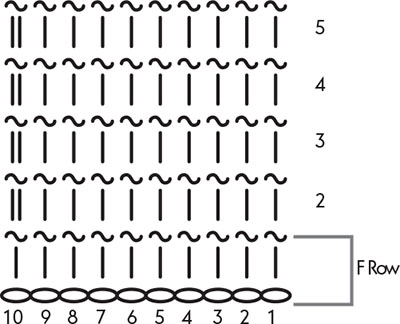
Tunisian crochet patterns are written in the same style as regular crochet patterns, but with a whole new set of stitch abbreviations to get used to.
The first step to approaching any pattern is to read through it entirely before you break out your hook and yarn.
Don’t worry if it doesn’t all make sense at first, some of the instructions will be clearer once you are actually making the project. The most important things to look out for are:
Regular crochet patterns can be written in either US or UK/Aus terminology. This can be confusing to even the most experienced crocheter, especially if it hasn’t been made clear what terminology has been used. If unsure of the terminology used, look out for ‘single crochet’ or ‘half double crochet’ as these are both exclusive to US terms.
Unlike with regular crochet patterns, Tunisian crochet uses the same international language for stitch names. However, as some Tunisian crochet patterns may also include crochet elements, it is important to understand which terminology has been used.
All the projects in this book have been written in US terms.
Check you have all the materials needed before beginning your project. There is nothing more frustrating than not having enough yarn to finish a project, especially if you are unable to get any more in the same dye lot or if it has been discontinued.
Matching the designer’s gauge isn’t essential if you are making a non-fitted item, but if you are making an item that must be a specific size then it is important that you match the gauge. Read more about this in the preceding chapter on Gauge.
Tunisian crochet patterns contain some familiar crochet abbreviations such as ‘ch’ for chain but there are also many new abbreviations to familiarise yourself with. There is no need to memorise every Tunisian crochet stitch abbreviation. As you begin working from Tunisian crochet patterns, you will quickly start to become familiar with the common stitch abbreviations such as Tss, which is used for Tunisian Simple Stitch. Refer to the abbreviations guide in the Glossary as you come across unfamiliar abbreviations. With practice, reading Tunisian patterns will become second nature.
If a special stitch or technique has been used in a pattern, the instructions will be written here together with its abbreviation. It’s a good idea to practice the stitch or technique before starting your project to get a feel for it. Once you begin working from the pattern and come across the abbreviation, refer back to this section for the instructions if a refresher is needed.
You will come across two types of charts in Tunisian crochet – symbol charts and colourwork charts. Both are very easy to use once you understand how to read them and you may find that you actually prefer them to written instructions.
Unlike crochet symbol charts, which resemble the finished item, Tunisian crochet charts are more like knitting charts. These charts use symbols to represent stitches or a pattern repeat and are easy to glance at when working on a pattern to see which stitch to use next, rather than reading through the words in a written pattern. You can also use both in conjunction with each other, referring to the symbol chart if you are unsure of the written instructions given or vice versa.
Unfortunately, with the exception of a few, the symbols are not universally standard, so they may vary from designer to designer and you should refer to their symbol key when working from a pattern.
For a key to the symbols used in this book, please refer to the Symbol Chart (see Glossary).
Tunisian symbol charts are read from bottom to top and each row is read starting from right to left.

Each row contains symbols for both the forward pass (they differ depending on the stitch used), and the return pass, which is notated with ~ symbols across the top of the row.
When working any colourwork pattern, whether it is intarsia or stranded, you will most likely work from a colourwork chart. These charts show the design clearly and working from them makes it easy to see where the colour change occurs and how many stitches to work in each colour.
Colourwork patterns will usually start off with written instructions to set up your project with the foundation row. They will then direct you to work from the chart for the remainder.
Colourwork charts are fairly self-explanatory and will either show the complete design, or they may show only the pattern repeat section for designs where the same pattern is repeated several times.
Charts are read from bottom to top and rows are read from right to left.
